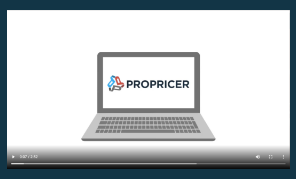If you’re entering the government contracting arena for the first time, it’s good to take a broad, top-level view of how you might approach what can become a lucrative business opportunity. This particular blog stays out of the weeds, and is meant to give you an overarching perspective on how to approach your new revenue stream.
The best proposals reflect a thorough understanding of an agency’s requirements, demonstrate the highest performance standards, make their submission deadlines, and deliver on price-value fit. Mastering the scientific art of government proposal writing and pre-award process is a long-tail venture. With practice, you’ll find your groove.
1. Writing your proposal
a. Before you write, read the RFP three times. Familiarity breeds success. The more you’re able to absorb what the government is looking for in a Request for Proposal (RFP), the more comfortable you’ll become with ways to present your content correctly. Look beyond the Requirements of Service included in the Statement of Work. Become familiar with the expectations included in the Provisions and Contractual Clauses sections as well, and make sure you consider them in your government proposal writing.
b. Prepare an outline of the Solicitation Requirements. Some RFPs include specifics on proposal length, content, format, areas to address, and presentation techniques. Once created, your outline of these requirements can serve as a helpful checklist. Map your writing to it at every step in the draft process.
c. If there are multiple authors, agree on tasks and timelines. Bring all members of your proposal writing team together for a 15-minute standup meeting, every other day as you write. Make sure each person understands their respective role in the government proposal writing process, and during your initial meeting, establish schedules for each proposal area’s preparation. If you find that responsibility areas overlap, adjust assignments as needed. In more complicated government procurements, your timelines may be several months. But in others, the agency you’re working with may allow only 30 days for writing—sometimes less. Proposal deadlines are usually non-negotiable.
d. Have your best writer edit all submissions into one voice. This point may sound trivial, but it’s actually the most important rule to follow in our list. Eventually, your proposal needs to read as if one person wrote it. But first, consolidate all writing efforts into one raw draft, then distribute to every team member for feedback. Ask each person to review all text for persuasiveness, clarity, confidence, accuracy, logic, and efficiency. Time-box this review, then have your best writer polish the draft into a singular voice—but also take care not to change the meaning of content they may be unfamiliar with. 1
2. Pricing your proposal
a. Obtain a Pricing Schedule. What is this and why do you need one? A Pricing Schedule is a useful tool that helps you quickly respond to fixed-price RFPs. It makes smaller procurements more cost-efficient for you, as it reduces the time you need to bid on fast-turnaround contracts. It also helps ensure that your calculations are accurate. For instance, if you want to negotiate a cost-reimbursement contract, the Pricing Schedule can help you avoid trying to barter with an agency over what’s allowable—it’s already spelled out in the schedule. Also: Each of your cost/price calculations has to directly relate to work described in technical and management volumes. A Pricing Schedule can aid you in keeping your numbers consistent with the RFP’s factors.
b. Review Section L of the schedule for all pricing volumes. The Federal Acquisition Regulation (FAR) determines the correct way to organize each proposal; you’ll find those instructions in Section L of your Pricing Schedule.
c. Prepare a Compliance Matrix for the cost volume. This cross-referenceable table demonstrates to an agency where and how you’ve responded to specific RFP requirements in your contract submission. It helps confirm that you’ve included all pricing information you need to be compliant.
d. Create a Basis of Estimates (BOE). One of the most critical parts of your proposal, a BOE, is your detailed analysis of an RFP’s Performance of Work statement, helping you accurately determine the total price you want to submit. Often your BOE is tied to price tables, creating a tight technical estimate—which often results in a more complete pricing model.
e. Factor in subcontractor rates and sealed bids. If you’re including subcontractor work in your proposal, make sure you can back up pricing versus cost data, as well as your sub’s ability to execute the work. If you’re dealing with a sealed-bid situation, the agency you’re working with will typically select the bid with the lowest price, however it will also consider the past responsiveness and responsibility levels of that contractor. There are no pre-bid negotiations here, so your price calculations are key to a profitable contract.
f. Have colleagues review the RFP and your draft. Once your proposal team has completed their first shot at pricing, have either your senior management or knowledgeable co-workers review the information and assumptions that are in your proposal response. Outdated technical or rate information can influence your entire pricing volume exercise; sometimes an objective eye is all you need to detect inaccuracies. 2
3. Packaging your proposal
a. Separate your Technical Proposal from your Pricing Proposal. Submit each part of your proposal individually, according to instructions you’ll find in Section L of your RFP’s cost volume. Often, you’ll need to submit each proposal type in a separate envelope. Include the respective solicitation number and your firm’s name and address on the outside of each.
b. Realize that packaging requirements from different requesters in the same agency can vary. Within one agency, procurement office requirements often shift from contract to contract, in terms of how to package your proposal. And even when you’re working with the same contracting officials on sequential proposals, don’t assume the requirements you fulfilled for March’s RFP will match October’s. Each RFP stands alone.
c. Know that a separate agency team evaluates each proposal type (this can work to your advantage). A technical evaluation team reviews your Technical Proposal, and a pricing evaluation team looks at your Pricing Proposal. Neither team is given a copy of the other proposal. This allows the technical team to focus solely on technical details, and not be swayed by knowledge of which contractor came in as the low-cost bidder. At times, a Technical Proposal winner is slightly higher in price, yet delivers a better value by delivering an excellent technical product. Often this is enough to sway the Pricing Proposal judges to award the overall contract to the Technical Proposal winner. 1
d. Present your proposal in a format agencies are glad to accept. Both your team and the agency team should be on the same formatting page in order to efficiently review, negotiate, and award government contracts. To accomplish this, both teams should ideally use the same proposal platform. ProPricer Contractor Edition provides you with the software and resources you need for a successful bid process and fully syncs with ProPricer Government Edition on the agency side. With Contractor Edition, you’ll prepare your proposal using a modern SaaS tool that synchronizes data, generates pricing reports, initiates complex what-if scenarios, standardizes your pricing environment, and more. If you’d like to give ProPricer a try, you can use our ProPricer Express edition for free. See how easy it is to convert an existing proposal into ProPricer format. Or request a live ProPricer Contractor Edition demo here.
4. Submitting your proposal
a. Submit only what is asked for. Include everything the government requires in your proposal—but nothing less and nothing more. If you exclude relevant technical details or include long-winded narratives when they’re not specifically asked for, your proposal may not be included in the competitive range. And as a result, you won’t be eligible for a contract award. Again, pay particular attention to the agency provisions outlined in Section L of the contract’s RFP, and follow these instructions to the letter.
b. Mail your proposal well in advance of its deadline. Don’t wait until the last minute to submit your proposal in response to an agency’s solicitation. Mail your proposal at least a week ahead of the deadline, and send it by certified or registered mail. Don’t run the risk of wasting the time, effort, and money you’ve spent preparing your proposal—only to miss the deadline.
c. If hand-delivering your proposal, submit only to the correct office and official. You can hand-carry a proposal to the government, but make certain you deliver it to the agency’s acquisition office, and specifically to the correct contracting officer working there. The person at the front desk in the lobby of the agency’s federal building can guide you to the correct floor, but never leave your envelopes with that receptionist directly. Once you’ve located the correct contracting officer, you can ask for a receipt. Of course, these rules only apply to new agency relationships. Once you know the ropes and people involved, the process can be more relaxed.
d. If your submission is late, be prepared to present evidence as to why. There are times when an agency will accept a late proposal if a contracting officer has made a modification request or asked for a “best and final offer” late in the game. Rarely does this happen, and it’s pretty much the sole exception for the government’s acceptance of a late proposal. If the government has mishandled your proposal on their end—such that it’s received by a contracting officer past a deadline—you’ll be asked to present postmark and tracking evidence that proves you weren’t delayed in your submission process. 1
Attend the 2022 Government Contract Pricing Summit: Cultivating Agile Solutions
It’s time. Gain valuable proposal pricing and packaging insights from industry thought leaders, and network with contractor and agency colleagues from across the nation.
When: June 14-16, 2022
Where: San Diego, CA and online
How: Don’t wait. Get a great rate. Register here.
Sources
2 Cavu Advisors Article - Five Best Practices, Three Bad Mistakes




